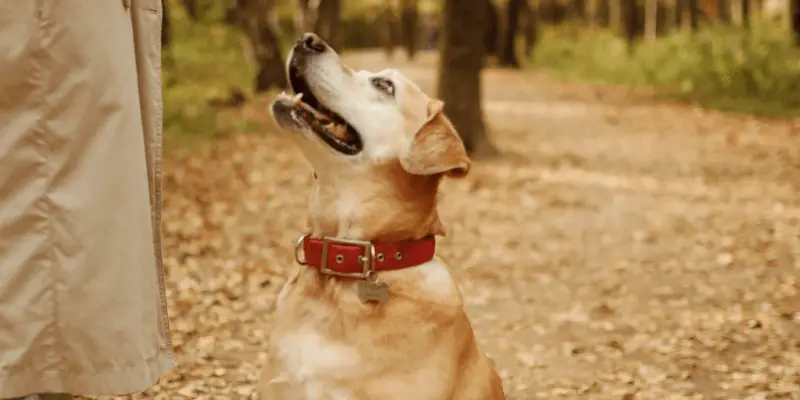How Should You Place a Prong Collar on a Dog

Every dog owner aims to provide the best training for their dogs. However, controlling them can sometimes be challenging, no matter their breed or level of training. In these instances, utilizing your dog’s collar can be very useful.
What’s the correct way to put a prong collar on a dog? This guide will enlighten you on the subject. Prior to diving into the main content, let’s go over the fundamental information.
There are various types of dog collars such as a flat collar, choke collar, martingale collar, and regular collar. They are mainly used for training and reinforcing leash manners in dogs.
In addition, prong collars can also be used in training sessions and they’re very helpful in leash training for your dog.
A prong collar is a training tool for teaching discipline and restraint to a dog. These dog-training collars have been in use for centuries now but were made popular only after the 1960s. A prong collar is a vital part of a dog’s training in many settings across the globe
Is it Essential to Train Your Dog?
Proper training of any domesticated dog is essential.
Trained dogs are always better behaved at social gatherings, exciting events, or any cheery moment that has the potential to go explosive. They are also better companions as they are more mindful of their owner’s needs.
Untrained dogs often become aggressive which leads to negative reinforcement of their unwanted behavior These dogs can bite people, including children, in a gathering and cause chaos. Most often, this type of behavior is exhibited by anxious dogs.
Training a dog also helps in the proper sanitation of a dog’s waste as the dog knows when and where to go about its business.
How to Train Your Dog Better?

One of the best methods to teach dogs discipline, for example, is the reinforcement method. This method relies on providing encouraging and discouraging feedback depending on the desirability of a dog’s actions.
Often, this feedback is given to the dog through a physical input, such as pulling or letting go of the dog’s restraint. Prong collars for dogs are an example of a tool that can be used to deliver feedback to the animal.
Most dog collars can make training dogs easier. This is why you should pay attention to your dog’s collar
How to Put a Prong Collar Correctly
Prong collars are restraining collars with metal spikes on the inner side. They are also called training collars because dog owners, or a dog trainer, use them for training their dogs.
When using a prong collar on your dog, you must ensure proper placement as the metal prong points inwards. If the prong collar is too tight, or not properly fitted on your dog, it can damage your dog’s trachea.
Structure of a Prong Collar
A prong collar is like the traditional collar, but with metal prongs on the inside. The band itself can be made of either nylon or leather. The sharp prongs sit in pairs on either side of the band.
The metal or rubber-tipped prongs on the inside of the collar make close contact with the dog’s neck. However, they do not press into it when the dog is calm.
How do Prong Collars Work
Prong collars work like a choke chain for your dog. They tighten to cut off circulation and breathing when the leash is pulled, which stops the dog in its motion.
While the ethical standing of using prong collars is debatable, there is little doubt about the fact that these dog collars can harm a dog if not used properly.
Using such a collar on your dog is not only difficult but also dangerous. Luckily, we’ve amassed a bunch of tips to help you put on your dog’s prong collar properly.
How Should You Place a Prong Collar on a Dog?

The spikes on a prong collar can cause scratch marks on a dog’s neck. Moreover, there is always the risk of poking the spikes in the dog’s head, or eyes when putting the collar on its neck.
Safe Method of Putting on a Prong Collar on a Dog
When putting on a prong collar, make sure to point the spikes away from the dog’s ears, eyes, and muzzle.
Try to put it on in one smooth go. However, also remember to take your time while putting the collar on a dog, especially if it’s your first time.
Avoid jerky movements when putting the collar on your dog’s neck. Your dog will move a lot if you are jittery which can cause an injury.
Make sure the prong collar is properly fit on your dog’s neck. A sagging collar will simply slide down the dog’s neck. Too tight, and it will constantly cause pain to your pal.
How to Add More Safety When Using Prong Collars
Putting on a prong collar properly on your dog is crucial, but you can also take more steps to ensure that your dog remains as comfortable while wearing it.
Always keep a backup collar around, when using a prong collar as your dog can react to it aggressively.
Some precautions to take when using a prong collar:
- Ensure that you take off your dog’s prong collar when they are sleeping. While your dog can sleep wearing a prong collar, we can’t imagine how it would be any bit more comfortable.
- You can also take the collar off when playing with your dog, or when it is time to feed your dog. Dogs wearing a prong collar might hurt themselves if they get too excited.
- Always make sure the prong collar does not fit snugly, as it may cause constant pain. Look for any spike marks on your dog’s neck throughout the day and make leash corrections accordingly.
- Take the prong collar off when a dog is given to a new handler. This is to prevent any accidents while the dog gets used to its new person.
Can You Train Your Dog Better Using a Prong Collar?

While prong collars are dangerous, their effectiveness in teaching dogs restraint and discipline remains undisputed. Several reviews document that prong collars are useful tools in dogs’ training.
Benefits of Using a Prong Collar on a Dog
A prong collar establishes an owner’s dominance whenever their dog behaves undesirably, for example jumping and pulling when on a leash walk.
Another benefit of using a prong collar on your dog is that it conditions the dog to act in a disciplined manner whenever it’s wearing a prong collar. You can put on the prong collar whenever you want your dog to behave, such as when on a walk or among a group of people.
The Bad Side of Prong Collars
While there is little doubt that prong collars work, they are not an exclusive solution. Many other training methods provide equal effectiveness in teaching discipline and restraint to a dog
There is also an argument to be made about the ethics of using prong collars. Many believe that these dog collars are dangerous and cause severe pain to the dog.
Moreover, the technique of using a prong collar to train dogs is outdated.
Are Prong Collars Painful for Dogs and Should I Use Them?

The spikes on the inside can cause significant damage to the dog’s ears, or eyeballs, including blindness; if not handled carefully.
Pronged Collars – A Bad Idea?
Sometimes, big, aggressive dogs can pull on their leash a little too hard causing the spikes to pierce into their skin. Dogs can often catch infections through wounds on their necks.
The pain caused by a prong collar may also instill in the dog a sense of resentment towards its handler. This can severely affect the relationship between the dog and its owner, which is not ideal for training a dog.
Therefore, it is always recommended to explore and study the different types of dog training collar options for your dog.
Dogs Prong Collars – The Final Verdict
Those in favor of using prong collars often debate that dog owners should always maintain some level of dominance over their pets.
While this may be true, there are other less cruel training methods that don’t involve invoking physical pain to the animal. The popular belief is that using a training collar, such as a prong collar, is cruel and, therefore, unethical.
